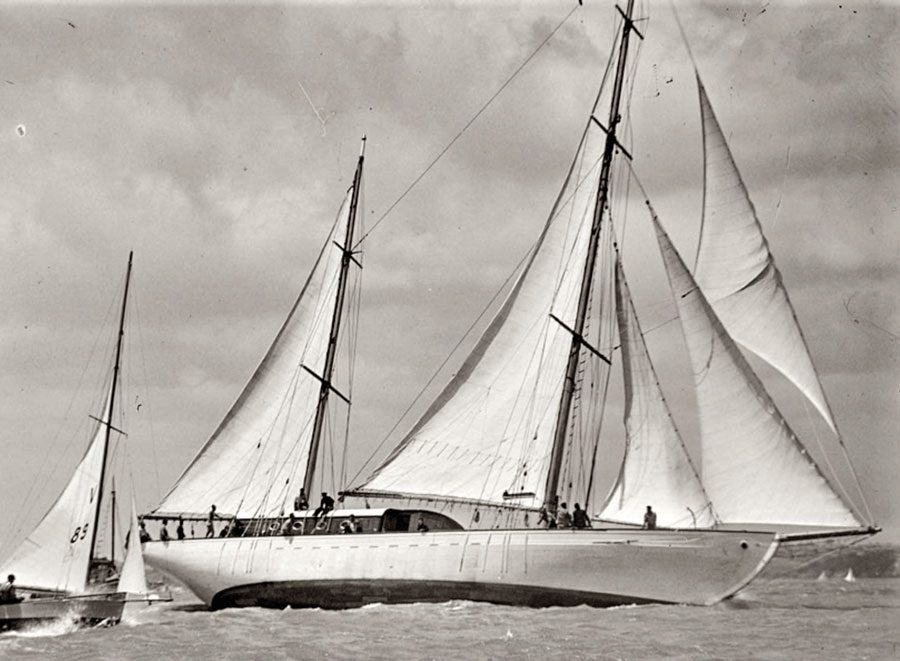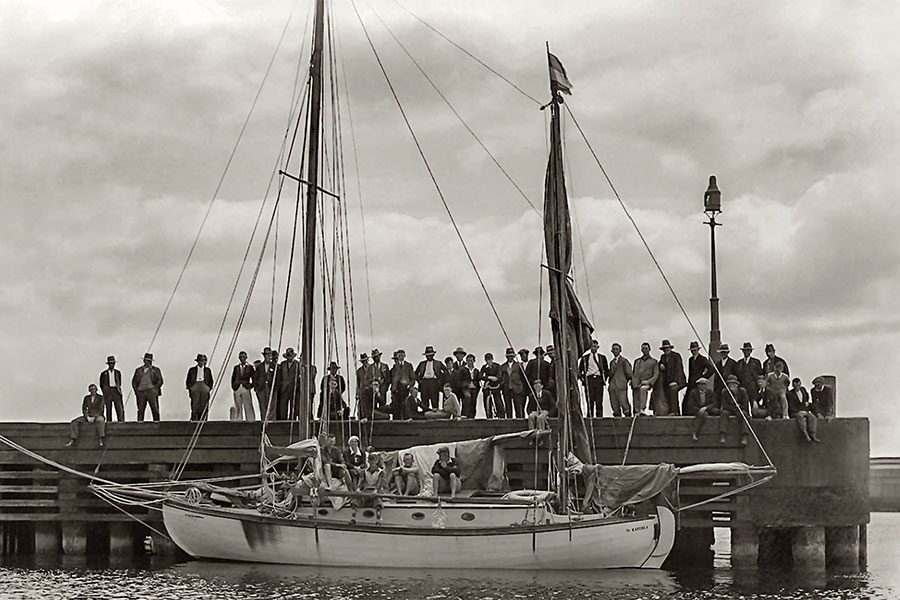

Seven months after she was rescued from almost certain destruction in Sydney, the 124-year-old gaff-cutter Ida is about halfway through a complete restoration, scheduled for a Christmas relaunching into her home waters – the Hauraki Gulf. Lawrence Schaffler has the story.
Readers may remember that Ida returned to New Zealand in December last year after some rapid and nimble footwork from John Street – the chairman of the Classic Yacht Charitable Trust – who negotiated her purchase from the Australian owners. At the time, he pointed out that Ida was an important part of our maritime heritage. Securing her and getting her back to New Zealand was one thing – restoring her quite another.
Designed by Charles Bailey Junior, Ida was launched in December 1895 in Auckland. Some 58-foot LOA (including her bowsprit), she is a triple-skin construction (kauri) and was built to challenge the supremacy of the speedy Logan-designed 5-raters on the Waitemata Harbour.
 Gaff-rigged and flying a ridiculous amount of sail, the 5-raters carried between eight and 12 crew, and by all accounts handling them was quite a challenge. Though arch-rivals, the Bailey and Logan boatbuilding dynasties are widely regarded as the founders of New Zealand’s yacht building industry.
Gaff-rigged and flying a ridiculous amount of sail, the 5-raters carried between eight and 12 crew, and by all accounts handling them was quite a challenge. Though arch-rivals, the Bailey and Logan boatbuilding dynasties are widely regarded as the founders of New Zealand’s yacht building industry.
Ida’s racing performance was a little lacklustre initially, but after some rig/sail tweaking by a later owner, she found her stride and proved up to the task.
How – and exactly when – she came to be in Australia is something of a mystery. But Street believes her removal – some time in the early 70s – from New Zealand was illegal. Classic boats such as Ida are covered by New Zealand’s Antiquities Act 1975, now the Protected Objects Act – which prohibits the export of items considered part of the country’s heritage.
As the images show, Ida was in a pretty sorry state when Street looked her over in Sydney, but a detailed examination suggested her kauri hull was sound, albeit with a bit of rot in a section of the inner and middle skins.

To restore her, he delivered her into the safe hands of Wayne Olsen, whose boatshed is located at Stillwater, north of Auckland. Street and Olsen have a lengthy working relationship around classic yachts, the latter having tackled the restoration of quite a few over the years, including Gloriana, Thelma and, more recently, Rainbow ll.
For a 124-year old yacht, says Olsen, Ida has stood up remarkably well. “She has a very unusual sheer, but looking at her from the side, there was absolutely no hint of ‘droop’ at either end. That’s always a good sign and suggests the hull is in good shape.”

Still, Ida’s resurrection has demanded significant structural repairs. In addition to scarfing in new sections of kauri to replace the rot under the old engine bed, Olsen has fitted new floors, an entirely new interior, new deck beams, a new samson post and a new rudder (with new pintles). Her plywood decks will be covered with teak planking.
One of her previous Australian owners (and it seems there were quite a few) had added a doghouse to the yacht, but Street and Olsen agreed that she should be returned to her original flush-decker design, so the doghouse has been biffed.
Ida is distinctive in many ways and the filigree gracing her bows and stern is particularly attractive. While it’s in poor condition and cannot be reused, it will serve as the templates for the replacements.
Her keel bolts are in good condition, but the ancient Drofin engine has been discarded – she will instead receive a new 20hp Beta diesel. Olsen will also build a new mast, boom, gaff and bowsprit – all in spruce – as the existing items are ‘very, very tired’. She will receive new running rigging and wooden blocks, and new bronze fittings such as the gooseneck and chainplates will be cast – after Olsen has created the patterns.
Crawling around inside the hull with its very limited headroom, it’s hard to imagine that anyone will spend much time below. But Ida will nevertheless be equipped with a toilet – and a holding tank.
An Australian owner had ‘splined’ the hull. This process sees a triangular section of ‘beading’ glued into V-profile channels gouged between the hull planks, eliminating the need for regular caulking. Olsen will replace some of the damaged splining.
He concedes that some purists aren’t in favour of this strategy, but points out that ongoing maintenance is one of the greatest challenges with old classics, and splining is designed to reduce maintenance.





